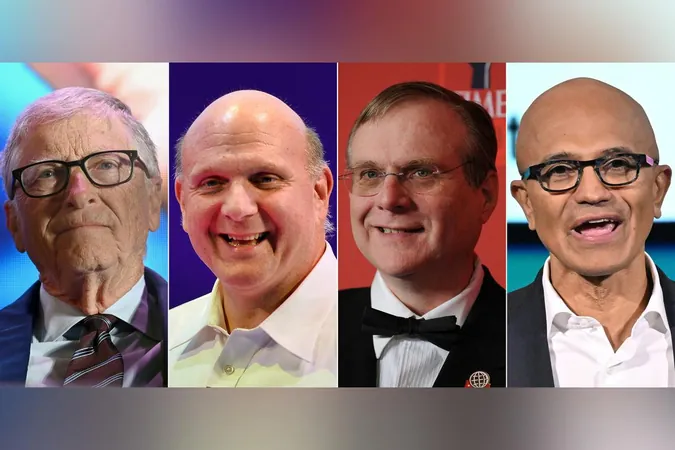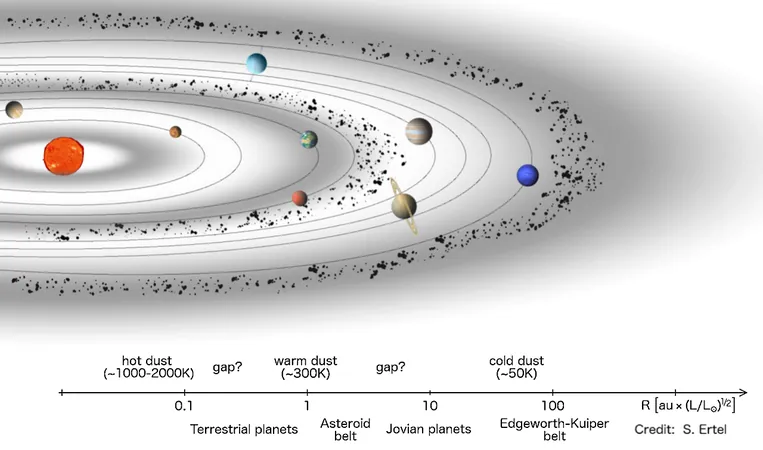
The Giants Behind Microsoft: A Legacy of Innovation and Controversy
2025-03-31
Author: John Tan
Bill Gates: The Visionary Creator
Born in 1955, William Henry Gates III, better known as Bill Gates, began his programming journey at the tender age of 13. His passion for technology led him to drop out of Harvard University in his junior year to co-found Microsoft with childhood friend Paul Allen in 1975, with the ambitious aim of putting a computer in every home and office.
Under Gates' leadership, Microsoft launched the revolutionary MS-DOS operating system, which evolved into the Windows operating system that dominated the personal computer market. While Gates is often celebrated for his visionary approach, he has also faced criticism for his aggressive business tactics and monopolistic behavior. This culminated in a notable antitrust case by the U.S. government in the late 1990s, which accused Microsoft of anticompetitive practices.
In 2000, Gates stepped down as CEO, handing the reins to Steve Ballmer, and redirected his focus towards philanthropy, establishing the Bill & Melinda Gates Foundation, which addresses global health and education issues. Though Gates resigned from Microsoft's board in 2020 amid rumors of a past relationship with a company employee, his legacy remains a cornerstone of the tech world.
Paul Allen: The Co-Founder Who Pioneered Change
Paul Allen, born in 1953, was not just Bill Gates' co-founder but also a visionary thinker who played a crucial role in the formation of Microsoft. His early interest in computers led him to inspire Gates to seize the opportunities in what was then an emerging tech revolution. Gates has often credited Allen with being essential to Microsoft's success.
Despite leaving the company in 1983 due to health issues, Allen remained a significant figure in technology and philanthropy until his passing in 2018. His ventures included investments in several industries, and he was known for his commitment to science, technology, and sports.
Steve Ballmer: The Energizing Force
Steve Ballmer, a Michigan native and a Harvard graduate, joined Microsoft in 1980 and quickly became known for his relentless enthusiasm and sales prowess. Taking over as CEO from Gates in 2000, Ballmer's tenure was defined by a focus on revenue growth, though critiques highlighted his neglect of innovation in favor of traditional software markets.
Under his leadership, Microsoft launched successful products like the Xbox gaming console and expanded into mobile with the acquisition of Nokia’s mobile phone division—though not without facing challenges like lackluster devices and software endeavors. His boisterous personality helped define Microsoft's company culture, and he remains an iconic figure in Silicon Valley.
Satya Nadella: The Innovator for a New Era
In early 2014, Satya Nadella took the helm as CEO and has since transformed Microsoft into a cloud-first and mobile-first powerhouse. His approach emphasized innovation and adaptability, shifting the company’s focus toward cloud computing and artificial intelligence. Under Nadella, Microsoft invested heavily in companies like OpenAI and acquired gaming giant Mojang, known for the wildly popular Minecraft, and professional network LinkedIn, significantly expanding its product portfolio.
However, Nadella’s journey was not smooth sailing; he faced backlash for an insensitive remark regarding pay raises for women in tech, which highlighted the ongoing challenges surrounding diversity and equity in the workplace.
The Legacy of Innovation and Controversy
The stories of Gates, Allen, Ballmer, and Nadella reflect both monumental achievements and controversies that have shaped not just Microsoft, but the entire tech landscape. As the company continues to innovate and adapt to the rapidly changing technological environment, the influence of these four men will always resonate in its history and future. In the ever-evolving world of tech, one thing is clear: their legacies are intertwined with the very fabric of modern computing.




 Brasil (PT)
Brasil (PT)
 Canada (EN)
Canada (EN)
 Chile (ES)
Chile (ES)
 Česko (CS)
Česko (CS)
 대한민국 (KO)
대한민국 (KO)
 España (ES)
España (ES)
 France (FR)
France (FR)
 Hong Kong (EN)
Hong Kong (EN)
 Italia (IT)
Italia (IT)
 日本 (JA)
日本 (JA)
 Magyarország (HU)
Magyarország (HU)
 Norge (NO)
Norge (NO)
 Polska (PL)
Polska (PL)
 Schweiz (DE)
Schweiz (DE)
 Singapore (EN)
Singapore (EN)
 Sverige (SV)
Sverige (SV)
 Suomi (FI)
Suomi (FI)
 Türkiye (TR)
Türkiye (TR)
 الإمارات العربية المتحدة (AR)
الإمارات العربية المتحدة (AR)